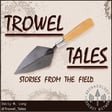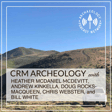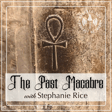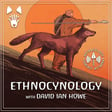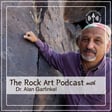Become a Creator today!Start creating today - Share your story with the world!
Start for free
00:00:00
00:00:01

Bone of Contention - Episode 4
In this episode, we explore the study of human remains with an emphasis on treating every individual with respect and care. Two bioarchaeologists share their experiences of working with human remains and how to best treat the individuals. Three archaeologists share their collective experiences of excavating a cemetery in New Jersey. Please note that all of the stories recorded were shared by professionals in the field who work within CRM law; this podcast does not endorse the disturbance of burials/human remains without thorough consultation, working within CRM law, and extreme care.
Transcript
Introduction to Archaeology Podcast Network
00:00:00
Speaker
You are listening to the Archaeology Podcast Network. Warning.
Trigger Warning: Human Remains Discussion
00:00:05
Speaker
This episode contains content about excavating human remains that some listeners may find disturbing.
Exploring Human Remains in Archaeology
00:00:18
Speaker
Welcome to Episode 4 of Trial Tales, Stories from the Field. On this episode, we're going to get into stories about excavating and studying human remains. It's a controversial topic and can be an incredibly emotional subject. For some archaeologists, removing human remains and studying the bones is just another part of the job. For other archaeologists, it is seen as something that should be avoided at all costs.
00:00:45
Speaker
or it can even be a mix of all of the above. Outside of the field, uncovering skeletons during professional excavation gets all kinds of reactions from, wow, cool, to accusations of grave robbing. There are major cultural and religious differences, too, in how people view the study of human remains.
Historical and Cultural Practices
00:01:09
Speaker
Unfortunately, there are examples of early archaeologists in the United States digging up the graves of prehistoric peoples without any thought to their descendants. Even though practices have changed quite dramatically over the years, as well as cultural resource management laws and the ways we protect human remains, the fact that there is a large range of opinions is not surprising.
Ethical Considerations and Respect
00:01:32
Speaker
I spoke to a bioarchaeologist about her experiences of working with human remains.
00:01:40
Speaker
I mean I won't get into specifics about time frame or anything but you know just individuals that were probably young males and you could see obvious trauma to their cranium and
00:01:55
Speaker
that always makes me sad because they were so young and then you could see that well it looks like infection might have set in and it's like if they lived with this trauma for a long enough for an infection to start that's just you know you kind of feel for them it's sad and sometimes like the infants and stuff when you can tell that they were buried with such care and they were loved and that's always you know kind of sad you know you just try to
00:02:22
Speaker
treat their remains as if they were living people. They had lives and thoughts and feelings and people cared about them. It's like you have to still kind of go with that.
Handling and Reburial of Remains
00:02:37
Speaker
There's ancestors and other people who still have strong connections to them even though they never knew them personally.
00:02:47
Speaker
So you just kind of have to take that into account when you're looking at remains, I think. A lot of times, people who are archaeologists act like working with the burials and human remains and whatnot as some kind of blue ribbon or a badge that they've earned. Like, oh yeah, I've done that. I'm really cool. And it's like, no. It's like, first of all,
00:03:11
Speaker
It's not, I don't like that they have to be disturbed to begin with. I mean, I like to think of it as salvage work more than anything. I don't want to go in and disturb them unnecessarily, but sometimes, you know, in order for progress to be made, it happens and it's unfortunate, but you know, it's best to handle it with as much care and respect as possible so they can eventually, you know, sooner as opposed to later be given back to the
Firsthand Encounter in Wyoming
00:03:37
Speaker
right people who will rebury them and hopefully give them their final resting place where they won't have to be disturbed again.
00:03:48
Speaker
What it boils down to is the need for respect and to treat the remains with care. This need for respect begins from discovery in the field to its potential removal. It isn't common to find a burial while doing a basic survey, but it does happen. It can be a unique and unnerving experience. All right, so this is actually about the first time I ever encountered human remains.
00:04:18
Speaker
which can be a tense subject with some folks. And it affected me pretty profoundly. So I was working, we were working on a project that was like east of the Big Horn Mountains up in Wyoming. And it was a Saturday. I had volunteered to go out in the field because usually I'm in the office. So we kind of feel time is always fun.
00:04:37
Speaker
although it was early so we were driving around the project on some of the pre-existing roads that were there and I was sleeping in the front driver's seat and all of a sudden the lady who was driving stops and like wakes me up Seth look out your window I'm like what? look out and in the cup bank of the road you can see a human skull it's just sitting right there so I uttered some expletives and I woke up the guy behind me
00:05:07
Speaker
and asked him to look out the window and he had a very similar reaction to me. So we stopped it, everybody got out of the car and we're looking around and so there's a
Discovery Reaction and Protocols
00:05:17
Speaker
skull. We can see some bone exposed, other bone. We didn't do any kind of excavation there because we had to alert the proper authorities. There's a whole big rigmarole that needs to be done when you find human remains. But we could see the skull and then we could also see a little charcoal lens in the cup bank.
00:05:37
Speaker
So it was, there was a fire there too, about the same level. So it might be at the same time. But so later we're back in town. Everybody's at the bar as things go and they're all talking about it. Like, Oh, now when I was in school, you had an osteology and we had to look at all these bones. Like, well, I didn't do any of that stuff. I made pottery in school. So I didn't have any kind of experience with dead people. It's like, this is like, that's a, that's a person.
00:06:07
Speaker
It's not a collection of bones. It's a person. They had a life. They knew people. And then they somehow found themselves out on the plains of Wyoming and they're dead. I guess later the University of Wyoming excavated the actual site and was a woman about 35. I think she was a couple of thousand years old. But it wasn't really a barrel because she was face down.
00:06:38
Speaker
So it was weird. I missed the presentation about the project.
Personal Stories vs. Artifacts
00:06:45
Speaker
It was at a conference, but I had a friend that saw it and she told me about it, but it's like it was a person. And then they had a story and we don't know what it was other than where they ended up. That's actually one of the things that I find most interesting about archeology.
00:07:06
Speaker
about how you can actually look at it as personal stories as opposed to like, it's not a culture, it's not the ancestral Puebloans or the Hohokam. Like there was a person there and they made that like arrowhead or they made that painting, it was a person.
00:07:24
Speaker
It was totally different then. You can't look around and see transmission lines there or other roads. They were there, traveling to someplace else for their own reasons, what those were.
00:07:41
Speaker
Federal and state cultural resource management laws in the United States protect graves and dictate the instances in which human remains may be excavated and possibly studied by professional archaeologists and forensic anthropologists.
Legal Protections and Excavation
00:07:56
Speaker
These laws, such as the Native American Graves Protection and Repatriation Act, outline the process of returning human remains.
00:08:06
Speaker
There is a lot involved. Consequently, the excavation of human remains is typically a last resort action. It is an incredibly careful process with ongoing conversations with local communities, interest groups, and Native American tribes.
00:08:25
Speaker
Typically, at least in the United States, the only time when burials are excavated are during major projects in which the remains will be disturbed or possibly destroyed if nothing were done.
New Jersey Cemetery Excavation
00:08:37
Speaker
I spoke to three archaeologists who excavated a cemetery due to major road construction. We're gonna talk about
00:08:50
Speaker
an excavation we did in New Jersey. It was a cemetery project with a big old crew. How many of us were there? I think at any one time there was between 50 and 60 field technicians and then supervisors in addition. It started small and then it... Didn't balloon. It ballooned and then it went small again, but it was over nine months? Ten months?
00:09:17
Speaker
You were there the longest. February did. I think you were there almost a year. February to November, I think. We were there.
00:09:23
Speaker
Six, seven months. Yeah, because we were there through Halloween. Folks were shunted off to do other projects and we stayed for reburial. We got to drive the box truck. Yes, I was given the keys to a shoddy old box truck with about 500 boxes full of human remains in the back.
00:09:48
Speaker
with no additional paperwork. I'm told to drive across the Jersey Turnpike to the place where we are reburying these individuals. What should I do if I get pulled over or anything? Don't.
00:10:05
Speaker
That's the best advice we have. Because there's no permit for anything like this anywhere. You will have no company information on you. Good luck! You will disavow all knowledge of your activities. I promise, officer, I'm not a psychopath. This isn't a weird collection of mine.
00:10:29
Speaker
So, but yeah, it was a huge project. It was in the 4,600 bodies were exhumed in advance of a parking garage along the Jersey Turnpike for the train. Yeah, for the commuter rail. It's a nice parking garage. We've parked there. Have you seen it? I had never been back. But this cemetery was a potter's field, the cemetery for a tuberculosis ward.
00:11:00
Speaker
mental hospital for also for a mental hospital. And then eventually, Children's detention center was built over it. Yeah, eventually, juvenile detention center. And it kind of turned into a dump. Yes. And then the turnpike was built over it. Yes. So it was a jumbled. It was a mess. It was a mess. It was a mess. Well, I remember when we got there, it had only recently been discovered that there was a second layer
00:11:30
Speaker
of individuals buried like graves that nobody was aware of. Like surprise, more dead people. But I feel like it makes sense for this project to be just interrupted. It was such a mess. What was the timeframe looking like when like the oldest body like from what was the timeframe period wise?
00:11:58
Speaker
I want to say 1880s to 1960s. 63 was definitely the last burial. Don't recall the first. I remember we had some individuals with Civil War medals on them, which obviously that date range would make sense. But I don't know if it went back to the 1870s or not. I just don't remember. I feel like it did. But I don't know. Yeah. Offhand.
00:12:25
Speaker
So it was because it was a potter's field, the way that the method of interring individuals there, they dug the grave shaft and someone would die and they would put a wooden casket with the body inside the shaft and the shaft would stay open for a couple days until another body came and then they would stack the caskets on top of each other then backfill.
00:12:47
Speaker
And like Sarah said, there was kind of two cemeteries on one because once they ran out of space in the cemetery, they went to those kind of the same shafts and dug another shaft on top of it. So you'd have two more bodies on top of the original two. And then over time, they kind of all just collapsed into a wooden bone jumbled mess. So what was it like to have to excavate something like that? Excavation is a stretch of a word.
00:13:17
Speaker
It was a, it was a removal. It was removal more than excavation, but complicated, messy, not under ideal scientific conditions, circumstances or timelines.
00:13:37
Speaker
And it didn't help that you're in the Jersey Meadowlands and it's swamp. And so you're dealing with groundwater that goes up and down. It's tidal. Exactly.
Emotional Impact on Archaeologists
00:13:47
Speaker
So in the morning, it might be, help me out with the tides, wet. I'm not going to be having to just try or vice versa, right? I grew up in Wisconsin, we don't have tides there. I don't, yeah, there were definitely some parts where
00:14:06
Speaker
it was muddy or you thought your the shaft you were working in was was just gonna be muddy and then you end up shoulder deep in New Jersey water. And there were snapping turtles everywhere. Yeah. And fish of sharks. Trying to figure out what was down there and
00:14:36
Speaker
fishing for remains. And that was- Most of the remains. Long bones. Yeah. Yeah. Long bones. Skulls. And because it was titled, not everything was as decomposed as it could have been. Yeah. Especially things that were in the mid 20th century. Yeah. That was gross.
00:15:03
Speaker
body tissues, brains, hair. Did that really stick with you? I didn't excavate a lot of the shafts. I was doing more of the backhoe monitoring, so I didn't experience that so much, but there was definitely individuals that were highly affected by
00:15:24
Speaker
really adversely affected by the experience. Some left the project, some muscled through, others might be just permanently damaged. They started out that way. They came into the project that way. I had nightmares of sorts for about a week after we were done with everything. Like it was fine.
00:15:45
Speaker
going through, it wasn't, you know, ideal, but it's important work. It was important work. You know, it needed to be done. And under the circumstances, it was, you know, as done as well as it could have been. But just to process it all, because how often do you see what almost 5000? You know, the remains almost 5000 individuals.
00:16:14
Speaker
in one place. You don't. No, you don't really want to. Not really. I had for some reason, I don't know why, I think it was because it was found near the morgue, which was the morgue is where the bodies were housed, which was the detention center, one of the buildings of the old detention center. And I remember, I don't know if you guys are caught, remember the the mason jar with the fetus?
00:16:38
Speaker
Cool. I had completely forgotten. It was probably like a hospital specimen. So it was a court jar or pint jar, but it actually had, so it was probably capped with formaldehyde or saline or whatever liquid they had in there with the, I think they said like a five month old fetus in there. And it was just kind of tossed into a grave shaft.
00:17:01
Speaker
And one of the field techs who was an incredible woodworker, I mean, it just, it hit home for him. He had a really hard time with it. So he made, he made the jar its own coffin. I mean, he went and took a couple of weeks and he was one of the ones very affected by the project as a whole, but he made a handmade coffin for that jar and it got re-interred at the new cemetery, but I completely forgotten about. Wow. Yeah, I'd forgotten about that too. Yeah.
00:17:28
Speaker
And weren't there a couple of bodies found in shower curtains?
Unusual Finds During Excavation
00:17:31
Speaker
Because New Jersey? Kaffa. There's one. Yeah, I remember the one. Yeah. And it was like 1950s. Yeah. Floral. And I believe there was a bullet recovered bouncing around in that scarf. Oh, really?
00:17:43
Speaker
I know there was a bullet recovered in at least one of the skulls. Yeah, I think a couple. Yeah. And then there was the guy who was, they think he was hit by a train or fell off a building. It was like every bone was shattered. Pre-mortem. She's shattered. Yeah. And the guy with the shoulder.
00:18:04
Speaker
remember he like dislocated his shoulder and it never got reset into position so he had like a second socket on his scapula. I don't think I saw that. Oh that was just like spectacular in like a weird osteological sense because it was just you know you had your normal socket and then the other one sorry nerding out the other one was like two inches lower and it had completely like carved into the bone to form a second. How painful. Right and I mean I'm sure it's just
00:18:39
Speaker
Let's take a quick break.
00:18:50
Speaker
The CRM Archaeology Podcast brings together a panel of cultural resource management professionals to discuss the issues that really matter to the profession. Find out about networking strategies, job hunting, graduate programs, and much more. We'll often feature interviews with college professors, CRM business owners, and experts
Sponsor Break
00:19:08
Speaker
as well. Check out the show on iTunes, Stitcher Radio, and at www.archaeologypodcastnetwork.com, forward slash, CRM Ark Podcast. Let's get back to the show.
00:19:33
Speaker
Welcome back. We'll
Eerie Experiences in New Jersey
00:19:35
Speaker
continue with the stories from the large-scale excavation of a New Jersey cemetery. One of my most vivid memories from that project is having to go into the body storage with a morgue, which is in the old dormitory of the juvenile detention facility during a lightning storm.
00:20:00
Speaker
but it was dark and there was no power in there anyway. I can't say most of that project got to me, but that was a lot of bad vibes stacked on top of other bad vibes. To be like so cliche, it's like the end of Raiders of the Lost Ark and it's just box upon box and it's just, there's no end to the aisles of, oh.
00:20:21
Speaker
Well, and you had to go through that to get to one of the areas we were excavating, too. I remember traipsing through the morgue, you know, every day for a period of time to get to that backside. You're right. Because, yeah, there was like that whole extension of the cemetery on the other end of that. Yeah. When we thought we were done, but we were not done. Right? That was the story of that project is, oh, we're done. Never mind. More cemetery.
00:20:49
Speaker
But when the juvenile detention center was built, they didn't care that there was a cemetery there.
Neglect and Mismanagement Issues
00:20:56
Speaker
And that was really apparent when I was excavating a partial shaft.
00:21:03
Speaker
that went into like a big concrete pier for the parking lot slash safety lights and so it was an individual's you know lower half I don't even think the pelvis was there it was just like part of the pelvis and the legs and the rest of the body was just
00:21:26
Speaker
gone. And that and stuff like that is why like this excavation was so important because the people in the cemetery just got screwed. Yeah.
00:21:36
Speaker
And after it was abandoned in 1963, the term, you know, all these things were built on it. And whatever headstones were there, which were numbered markers, they were kind of these cylindrical numbered markers, they had been shaved off. So we didn't find a single one of those in situ, but we found them scattered in the back dirt so you could come across one with a stamp. And so it was interesting though, because you know, everything was mapped and we had the historic map of the cemetery. So using in
00:22:04
Speaker
you know a road would go in one direction for a while and then kind of turn to the northeast or whatever direction and you could see that on the maps so you could count shafts to be like this could be so and so individual so there was some identification made based on osteology analysis and and the historic maps and occasionally because of artifacts that were found
00:22:28
Speaker
with the individuals, not so much, but some of them. Some of them, like the medals helped and there was the one woman who was interred with a full makeup kit and that was really cool and I think they were able to figure out who she was because of the makeup kit and because of osteological features. Didn't she have gowns?
00:22:50
Speaker
I don't recall that.
Preservation of Items in Cemetery
00:22:52
Speaker
It was totally flapper era. I remember that part. Yeah. So there was a box and glass eyes. Glass eyes, wigs. A lot of glass eyes, wigs.
00:23:02
Speaker
It's a little unnerving to come down on somebody's skull and have them look at you. Oh, the Ziegler box is what you're talking about. The Ziegler box is a metal box that we're in, I guess, you know, building more real morgues, not the detention center morgue, where they would pull the individual out and there would be a glass viewing window on the top of the metal box. And one of those for some reason was buried, the whole metal box with the body inside was buried in the cemetery.
00:23:28
Speaker
I thought it was to keep the tuberculosis in the coffin. Is that why? Not getting out of the way. And there we are digging it up. To contain the tuberculosis for the empire. But anyway, that was, whoever was digging that, they came across something and was like, what did I just hit? I think there was like lucky coins. There's that $20 gold piece from 1879.
00:23:51
Speaker
That was pretty special considering it was a potter's field. It was found by the guys, what would be his pocket of his trousers. It's really amazing that he was buried with that. It was never... Because that was the other thing that was surprising. A lot of individuals with gold teeth. You kind of would have thought back in that day that they may have been extracted prior to burial, but there was a lot of people with gold teeth. And all that stuff got re-interred. Yes.
00:24:19
Speaker
with individuals, with each individual body. Were there, like, considering preservation, was there anything that was preserved so well that you were really shocked that, like, clothing or anything along those lines, you were like, well, I can't believe that actually
00:24:37
Speaker
was still there. I think there was a couple of wooden coffins that survived, that were just kind of remarkable examples of the construction techniques of the time. But most of those were in pretty boggy conditions, so it's not surprising. I mean, initially, I think everybody was shocked, you know, the hair and the fatty tissue and everything that we were pulling out.
00:25:01
Speaker
And I think clothes too. I do recall a couple military uniforms. Yeah, even the bones. The bones ranged from, you know, faint outlines to very well preserved intact everything. I found a hyoid. Really? Yeah. And you don't find those. Yeah. That was really cool.
00:25:29
Speaker
But it was sporadic. One chef could have a hyoid bone, and the next might have nothing at all. Just a bunch of sludge. Yeah, it really was. The bones just turned to sludge. Yeah. And there was nothing you could, there was no, there's nothing you could do. There's nothing you could do. And they were re-interred in the second cemetery that we tried because the first one had another undocumented cemetery.
00:25:54
Speaker
Right next to it where we were going to re-enter these burials. That's right. Yeah, that's right because everybody the the PIs went off to go look at cemetery number one and came back and we're just like
00:26:14
Speaker
they'd seen, you know, bones on the surface. Jersey needs to work on your secretary.
Cultural Sensitivity and Respect
00:26:21
Speaker
I think it's the lesson we're learning here. If you're making your final arrangements right now, I would recommend going to Pennsylvania or New York.
00:26:39
Speaker
After the removal of human remains, and after many forms of consultation, bioarchaeologists and or forensic anthropologists study the bones. I asked a bioarchaeologist why she thought it was important to study bones in the first place.
00:26:58
Speaker
History pulls a lot of information from documents, and what was written down was generally the exploits of higher class individuals, both because they knew how to read and write, but they also had access to the materials to do so. That doesn't tell you a lot about what the
00:27:18
Speaker
like quote unquote normal people were doing. It's really, really great to be able to have this primary source that you can go look at someone's skeleton and actually see how someone lived. As scientists, you want to analyze the evidence in front of you to reach appropriate conclusions, but yes, these people were human beings.
00:27:45
Speaker
At some point, you obviously want to be respectful of that. You don't want to be, you know, you don't want to destroy anything. It's one of the reasons that we pad our work surfaces is to protect the human remains. Mostly it's about being culturally sensitive to the cultural group that that individual or those individuals that you're looking at come from. People who
00:28:15
Speaker
It doesn't bother that beyond the kind of, I don't like looking at human remains that might gross me out, but you are not opposed to people looking at human remains. There are other cultural groups, especially
00:28:33
Speaker
some indigenous or Native American groups that feel very strongly that they do not want the remains of their ancestors analyzed. We should 100% support the wishes of the descendants of cultural groups that do not wish for their ancestors to be examined. That being said, when you do find a grave archaeologically in the course of building a new building or
00:29:02
Speaker
regular survey, excavation, whatever it is.
00:29:06
Speaker
If you do not know who it is from, I think that you need to be able to do enough very general non-destructive analysis, but that it does not benefit anyone to find a skeleton, refuse to look at it, potentially give it back to the wrong group of people, or not be able to give it back to anyone and just have it sit in storage somewhere because
00:29:34
Speaker
You're afraid it might be something. And again, do that in as respectful and as non-destructive a way as possible. And just talk to people. Be in open communication with them. Respect people's wishes. It is hard. And I don't want to say that every case is different. Every person is different.
Conclusion and Feedback
00:30:00
Speaker
That's it for this episode.
00:30:04
Speaker
Special thanks to Aaron, Sarah, Jackie, Seth, Carrie, and Chelsea who contributed their time and stories to the podcast. The music you heard is by Pergola, so long, not goodbye. Check us out on Facebook to learn more about the podcast and let us know what kind of stories you'd like to hear. Also, if you're an archaeologist and would like to contribute a tale or two, send a message to trialtalespodcast at gmail.com.
00:30:33
Speaker
Until next time! This has been a presentation of the Archaeology Podcast Network. Visit us on the web for show notes and other podcasts at www.archaeologypodcastnetwork.com Contact us at chrisatarchaeologypodcastnetwork.com
